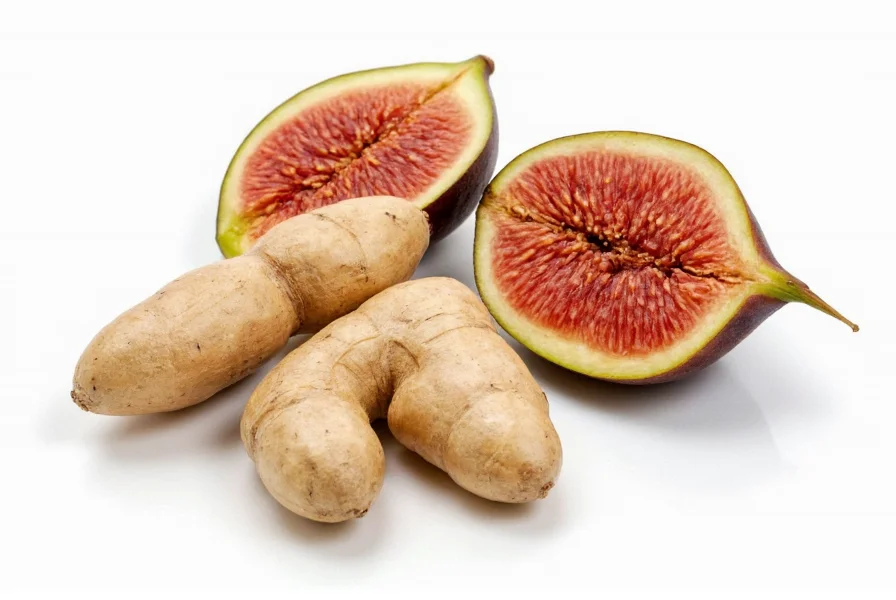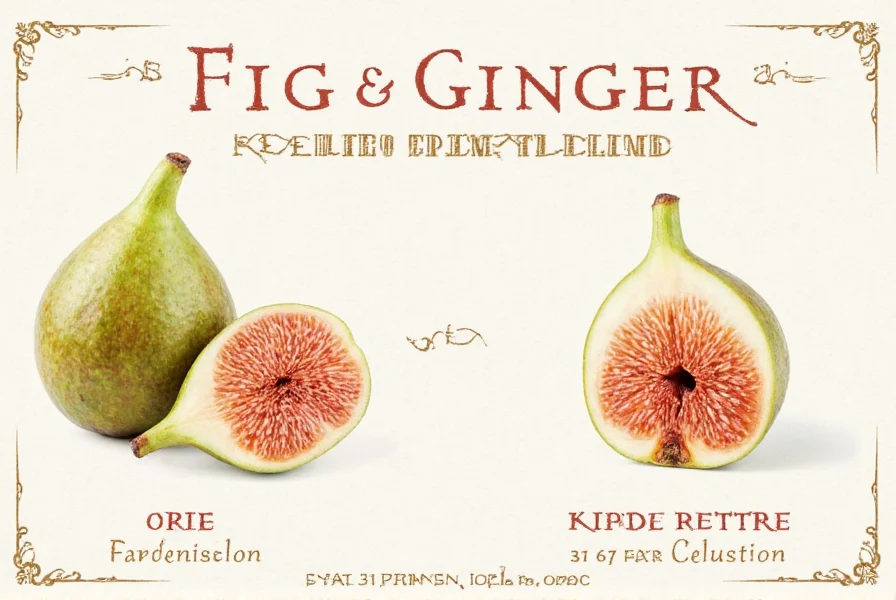Figs and ginger represent one of nature's most harmonious flavor combinations, blending earthy sweetness with vibrant spice. This pairing transcends mere taste compatibility, offering both culinary versatility and complementary nutritional benefits that have been appreciated across cultures for generations.
Understanding the Flavor Chemistry
The magic of fig and ginger pairing begins with their contrasting yet complementary flavor profiles. Fresh figs deliver a complex sweetness with honeyed notes and subtle berry undertones, while dried figs intensify these flavors with caramel and molasses characteristics. Ginger contributes its signature warmth, citrusy brightness, and slight peppery bite that cuts through figs' natural richness.
When combined, ginger's volatile compounds interact with figs' natural sugars, creating new aromatic compounds that enhance both ingredients. This chemical synergy explains why fig and ginger flavor profile analysis reveals such remarkable compatibility across various cooking methods.
Nutritional Synergy and Health Considerations
From a nutritional standpoint, figs and ginger create a powerful combination. Figs provide exceptional fiber content (nearly 15% of daily needs per serving), calcium, potassium, and magnesium. Ginger contributes gingerols and shogaols—potent anti-inflammatory compounds with documented digestive and immune benefits.
| Nutrient | Figs (100g) | Ginger (100g) | Combined Benefit |
|---|---|---|---|
| Dietary Fiber | 2.9g | 2.0g | Enhanced digestive health |
| Vitamin K | 15.9μg | 0μg | Bone health support |
| Gingerols | 0mg | 5-10mg | Anti-inflammatory effects |
| Potassium | 232mg | 415mg | Cardiovascular support |
This nutritional synergy makes the health benefits of figs with ginger particularly valuable for digestive wellness, with ginger aiding digestion while figs' fiber promotes regularity. The combination also creates a natural electrolyte balance that supports hydration—especially valuable during seasonal transitions.
Culinary Applications and Pairing Techniques
Chefs worldwide have mastered the art of how to cook with figs and ginger across multiple applications. The pairing works exceptionally well in:
- Savory applications: Fig-ginger chutney with roasted meats, particularly duck or pork
- Sweet preparations: Ginger-infused fig tarts, cakes, and breads
- Beverages: Fig-ginger syrups for cocktails or non-alcoholic drinks
- Preserves: Fig-ginger marmalade with balanced sweetness and spice
For optimal results when creating fig ginger chutney recipe ideas, use a 3:1 ratio of figs to ginger by weight. Fresh ginger provides brighter, sharper notes, while dried ginger (in small quantities) offers deeper, more concentrated warmth. When working with dried figs, rehydrate them in ginger-infused liquid to maximize flavor absorption.

Seasonal Considerations and Selection Tips
Fresh figs have a relatively short season (typically late summer to early fall in most climates), making seasonal fig ginger dishes particularly special. When selecting figs, look for plump fruit with unbroken skin that yields slightly to gentle pressure. For ginger, choose firm, smooth roots with tight skin and minimal wrinkles.
Proper storage extends usability: keep fresh figs in a single layer in the refrigerator for up to 3 days, while ginger root can be stored in a paper bag in the refrigerator for 2-3 weeks. For longer preservation, consider making fig ginger preserves storage tips-friendly preparations like crystallized ginger with fig compote, which can last 6-8 months when properly canned.
Cultural Significance and Historical Context
The pairing of figs and ginger spans multiple culinary traditions. In Middle Eastern cuisine, dried figs with preserved ginger appear in traditional meat tagines. Mediterranean cultures have long combined fresh figs with ginger in preserves and desserts. Asian culinary traditions incorporate young green figs with fresh ginger in savory preparations.
This historical usage reflects an intuitive understanding of the medicinal uses of figs and ginger—ancient Persian and Ayurvedic medicine both recommended figs for respiratory health and ginger for digestion, creating a natural synergy for wellness-focused preparations.

Practical Implementation Guide
For home cooks exploring this pairing, start with simple applications before advancing to more complex preparations. The best ways to use fresh figs and ginger include:
- Creating a simple fig-ginger syrup by simmering equal parts chopped figs and ginger in water with honey
- Adding freshly grated ginger to fig jam during the final 10 minutes of cooking
- Preparing a fig-ginger vinaigrette with fig vinegar, fresh ginger, and olive oil
- Infusing cream with ginger for fig panna cotta or custards
- Adding crystallized ginger to dried fig and nut trail mixes
When preparing fig and ginger tea preparation, use dried figs and fresh ginger slices simmered together for 15-20 minutes. The resulting infusion offers both soothing warmth and subtle sweetness without added sugar—ideal for cool evenings or as a digestive aid after meals.
Frequently Asked Questions
Can figs and ginger be used together for digestive health?
Yes, figs and ginger create an excellent combination for digestive wellness. Figs provide substantial dietary fiber that promotes regularity, while ginger contains compounds that stimulate digestive enzymes and reduce inflammation in the gastrointestinal tract. Together, they address multiple aspects of digestive health—figs with their prebiotic fiber supporting gut microbiome diversity, and ginger helping to alleviate nausea and improve motility.
What's the ideal ratio of figs to ginger in recipes?
The ideal ratio depends on the application but generally falls between 2:1 and 4:1 figs to ginger by weight. For sweet applications like preserves or baked goods, a 3:1 ratio works well. For savory applications like chutneys or meat glazes, a 2:1 ratio provides more ginger presence. When using fresh ginger, remember that its flavor intensifies during cooking, so start with less and adjust to taste. Dried ginger requires significantly less quantity—typically 1/4 to 1/3 the amount of fresh ginger.
How can I preserve fig and ginger combinations?
Fig and ginger combinations preserve well through several methods. For short-term storage (2-3 weeks), keep fig-ginger chutney refrigerated in airtight containers. For longer preservation, process fig-ginger preserves through water bath canning, which creates a vacuum seal allowing storage for 12-18 months. You can also freeze fig-ginger puree in ice cube trays, then transfer to freezer bags for up to 12 months. Drying figs with ginger syrup creates a shelf-stable product that maintains flavor for 6-8 months when stored properly in airtight containers away from light.
Are there any safety considerations when combining figs and ginger?
Both figs and ginger are generally safe for most people when consumed in culinary amounts. However, individuals taking blood thinners should monitor ginger consumption as it has mild anticoagulant properties. Those with fig allergies (relatively rare but possible) should avoid the combination. People with gastroesophageal reflux disease (GERD) may find that excessive ginger aggravates symptoms, though the fig component can help balance this effect. As with any food combination, introduce gradually to assess individual tolerance.
What are the best fig varieties to use with ginger?
Black mission figs offer the deepest, richest flavor that stands up well to ginger's intensity, making them ideal for preserves and baked goods. Calimyrna figs, with their nuttier flavor and thicker skin, work particularly well in savory applications with ginger. For fresh preparations, Adriatic figs provide a balanced sweetness that complements ginger without overwhelming it. When using dried figs, choose varieties with minimal sugar coating to maintain control over the final sweetness level of your fig and ginger creations.











 浙公网安备
33010002000092号
浙公网安备
33010002000092号 浙B2-20120091-4
浙B2-20120091-4